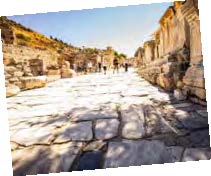Roman Beauty and Indulge Ephesus, Turkey
 By Ron McGinty
By Ron McGinty
Turkey is a mesmerizing country encompassing more history than most people realize
The imagined noises were raging in our ears, perched above the main Gladiator colosseum. The cries and echoes of requests for death traversing decades of history were ever-present. Here we witnessed the natural history of Roman society.
For a brief moment in time, we could experience the mindset of an everchanging world. Traveling through Europe, the Roman influence is evident everywhere. Impressively, Ephesus, Turkey, emphasizes Roman life in the sixteenth-century era. Their power came from an authoritarian regime known for notoriety, opulent structures, and lavish living standards.
 Through the ages, the wealthy were always flaunting their way of life. The upper-class slaves’ lifestyle was prevalent, comprising over thirty-five percent of the population. Slaves included many people, including Christians, and not only dark-skin individuals.
Through the ages, the wealthy were always flaunting their way of life. The upper-class slaves’ lifestyle was prevalent, comprising over thirty-five percent of the population. Slaves included many people, including Christians, and not only dark-skin individuals.
Irony loomed at this large Gladiator stadium because the honored them with a cemetery for the fallen adjacent to the arena’s walls of death. The victorious gladiators were world-class athletes. Cities loved the excitement of large-scale spectator games of chariot races, gladiator fights, and other sporting events.
The rich and extravagant homes had handmade, imported floors and wall tiles. Roman nobility loved to socialize in their homes, including large terraces for entertaining. Ironically, there was a communal latrine where people could chat about common topics while defecating. Conceivably this was not a concern because most did not wear clothing under a sheer silk toga.
 The Romans were highly sophisticated and well-educated, evident by the incredible ruin, the library, which is still partially standing today.
The Romans were highly sophisticated and well-educated, evident by the incredible ruin, the library, which is still partially standing today.
Latin was the primary language of the written word, but Greek was the essential spoken language More often than not, Romans spent time in multiple homes, for example, Ephesus to Pompeo.
Ephesus features an amphitheater that still holds 24,000 people. The stones in front of the arena were gravesites for those who perished in the games. They enjoyed dining out, gymnasiums, and bathhouses, not to mention sexual exploits.
Not to be denied all forms of pleasure, the city created prostitution zones. Plausibility, the town spawned the early “Red Light” district. This remarkable city had monumental accents of paved marble streets lined with tall marble columns. Strolling down the beautiful walkway, you envision the past hustle and bustle of neighbors and chariots.
 Turkey is a mesmerizing country encompassing more history than most people realize. Historians write, the Virgin Mary, mother of Christ, lived out her last days on earth in Ephesus.
Turkey is a mesmerizing country encompassing more history than most people realize. Historians write, the Virgin Mary, mother of Christ, lived out her last days on earth in Ephesus.
I visited that part of Turkey several years ago and was amazed by the stunning landscape and beautiful weather. A great deal of Christian history existed in the area; various Apostles lived and preached the word of Christ here. John the Baptist was also one of the more active people here.
The picture of the lady in red was Ms. Zebra Arsian Ceylan, our tour guide standing at the front wall of the Celius library. The library was the third largest in the Roman Empire, holding over ten thousand scrolls. I need to stop my history story about the Celius library because it can be too long. You need to travel to this part of Turkey and hire an excellent historian to tell you more.
 I hope this short article will give you an overview and stimulate your desire for a personal journey. Unfortunately, COVID-19 has triggered the cancelation of two of my international trips over the next few months. The good news, they were prepaid and could take place later in 2022. I expect to be back soon to share my travel experiences!
I hope this short article will give you an overview and stimulate your desire for a personal journey. Unfortunately, COVID-19 has triggered the cancelation of two of my international trips over the next few months. The good news, they were prepaid and could take place later in 2022. I expect to be back soon to share my travel experiences!




Leave a Reply
Want to join the discussion?Feel free to contribute!